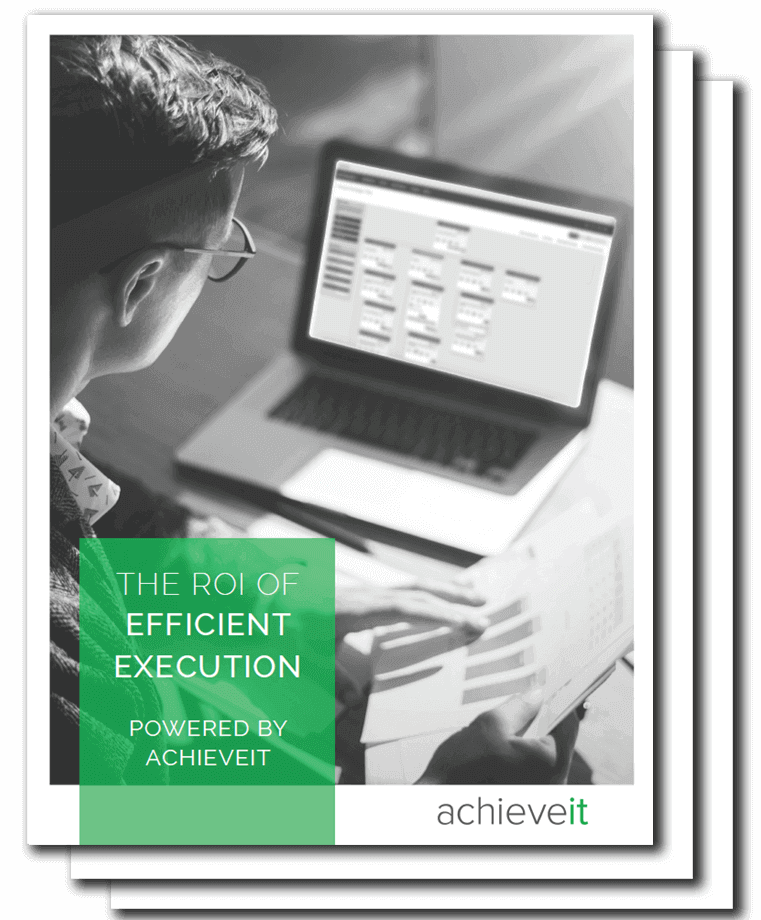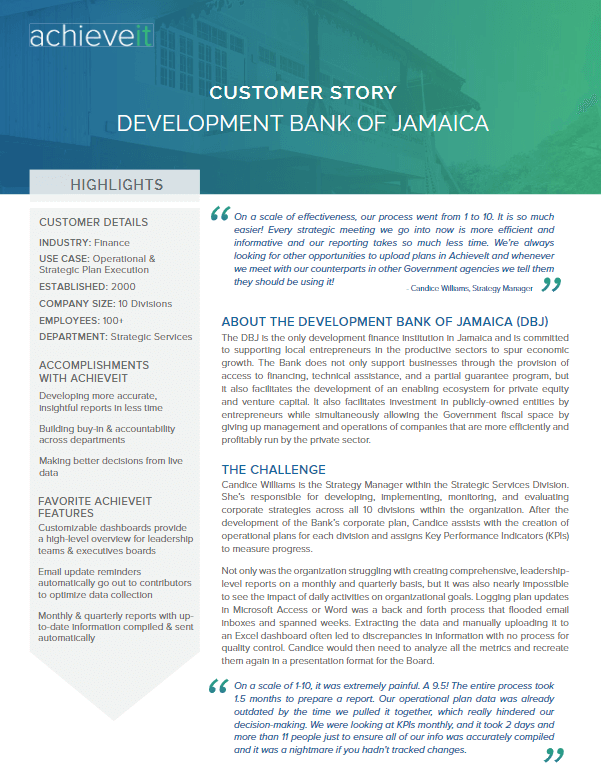In the world of strategic planning and execution, success depends on a lot more than just vision and ambition. It’s about setting a clear course, tracking your progress, and making data-driven decisions along the way. At the heart of this process lie key performance indicators (KPIs) and metrics.
KPIs and metrics are used to obtain a clear picture of an organization’s performance and its progress toward its strategic goals. They serve as the critical link between strategy development and execution, ensuring that objectives remain in focus and deviations are promptly addressed.
Jonathan Morgan, AchieveIt’s VP of Revenue Operations and Head of Marketing, has developed valuable insights into the process of setting KPIs, as well as common pitfalls that organizations encounter when doing this. KPIs and key metrics can be used to determine the success of your next strategic initiative. By following Jonathan’s advice, you’ll understand exactly how to maximize their effectiveness.
Set effective KPIs within your strategic plan
When it comes to using KPIs, strategic plans tend to fall on opposite ends of the spectrum. On one end lies plans that are devoid of metrics. They rely solely on qualitative descriptions that cannot be measured. On the opposite end, all you get are metrics but no clear strategy for using them to drive improvement.
According to Jonathan, success lies in striking a balance.
At the top of your strategic plan are your overarching goals or lagging metrics (or indicators). These represent the ultimate destination, the outcomes that you can’t affect directly but will improve over time through effort.
Leading metrics (or indicators) support your lagging indicators. These are elements within your control, offering immediate insights and the power to drive change. Jonathan says, “The hope is that, by accomplishing your leading metrics, you will positively affect your lagging indicators in the future.”
To illustrate this, imagine you set a New Year’s resolution to become a healthier person. You could choose to not measure anything, simply trusting that you’ll know when you’re healthier. Alternatively, you could attempt to measure every conceivable health metric, creating an overwhelming and unstructured plan.
The ideal approach, as Jonathan suggests, involves setting a clear lagging metric — such as losing 20 pounds — and supplementing it with leading metrics that you can actively measure. For example, you could set goals of exercising five days a week, maintaining a daily calorie intake below 1,800, and getting eight hours of sleep each night.
“An effective plan has both of those elements. You obviously need to be able to measure the success of the plan, but you also need to measure where you are on the journey there,” says Jonathan. Strategic planning backed by meaningful KPIs and metrics is a journey that requires you to monitor not only where you’re headed but also how you’re progressing along the way.
FREE RESOURCE
The ROI of Efficient Execution
Download this guide and the companion calculator worksheet to show your team what you’re leaving on the table without enabling plan visibility, organizational alignment, or automated accountability.

Picking the right metrics and KPIs
A common pitfall in selecting metrics and KPIs is overemphasizing leading indicators at the expense of lagging ones. While leading metrics are essential for monitoring immediate progress, too many can lead to a tactical focus that misses the bigger picture.
Let’s continue the analogy of a fitness journey. Imagine diligently tracking your daily exercise routine in your quest to lose 20 pounds but neglecting to monitor your calorie intake. You might be exercising rigorously, but if you’re consuming excessive calories, your goal of shedding pounds remains elusive.
The same is true in a corporate context. Consider a marketing professional solely fixated on driving website traffic. While an increase in visitors is a positive sign, if those visitors don’t convert into paying customers, the overarching goal of revenue generation remains unfulfilled.
To avoid these pitfalls, Jonathan recommends a clear alignment between leading and lagging metrics. “If the leading metrics you choose don’t contribute to these overarching goals, you’re wasting your time,” he says. Ineffective plans often lack this alignment, either blurring the distinction between objectives and execution or drowning in activity-based metrics that fail to drive strategic success.
“So plans that fail either don’t have that clear distinction between what you want to accomplish and how you’re going to accomplish it,” Jonathan says. “Or they just have all these activity-based metrics that ultimately don’t lead to where they want them to lead.”
By recognizing these common missteps and ensuring a strong correlation between selected metrics and strategic goals, organizations enhance their strategic planning and execution processes.
Measure the success of your KPIs AND strategy
When it comes to metrics and KPIs in strategic planning, the first hurdle many organizations face is spending too much time deciding which metrics to choose. Jonathan believes that it’s essential not to get overly bogged down by this decision despite its importance. What truly matters is getting started and ensuring that your chosen metrics serve one of three primary purposes: increasing, decreasing, or maintaining a certain value.
Often, organizations aren’t sure where to begin or what to aim for. Jonathan’s advice is to begin with what you have today and aim for incremental improvements. For instance, consider trying to improve your current revenue by 10 percent. This provides a starting benchmark, and you can adjust it as needed throughout the year.
Another sticking point that many face is overcomplicating the process. Rather than obsessing over whether your targets are perfect, focus on setting reasonable goals. Jonathan recommends aiming to achieve around 80 percent of your metrics. While hitting 100 percent is excellent, it might indicate that your goals weren’t challenging enough. Conversely, achieving only 20 percent can be demoralizing, suggesting that the goals were excessively difficult. Aiming for an 80 percent success rate allows you to maintain momentum and refine your strategy over time.
When assessing the effectiveness of your plan, pay attention to:
- Completion of initiatives: Evaluate how many of your planned initiatives or qualitative objectives have been successfully completed.
- KPI tracking: Monitor how your key performance indicators are tracking toward the targets you set.
- Timeliness of updates: Ensure that team members are consistently providing updates on time. Timely updates are essential to accurately track progress.
- Project timelines: Analyze whether projects are being completed ahead of schedule and assess the impact of any delays on the overall plan.
These aspects collectively contribute to measuring the success and effectiveness of your strategic plan, ensuring that you stay on track and make informed decisions throughout your journey.
FREE RESOURCE
Development Bank of Jamaica Customer Story
Read this customer story to better understand how a bank developed venture capital in Jamaica with AchieveIt.

How the Development Bank of Jamaica achieved KPI alignment and data-driven decision-making
The Development Bank of Jamaica (DBJ) stands out as a prime example of harnessing key performance indicators (KPIs) to drive success. Candice Williams, strategy manager at the DBJ, faced the complex task of aligning strategies across 10 diverse divisions, anchoring progress with KPIs.
AchieveIt’s strategic execution software and support team revolutionized the DBJ’s approach. By introducing dashboards and automated reporting, they streamlined operations, saving valuable time and resources. The user-friendly platform was swiftly integrated into the organization, enabling quick adoption.
The outcomes were remarkable. KPI alignment led to effective strategic implementation and data-driven decision-making. Most notably, the DBJ centralized all KPIs and operational plans, eliminating the need for laborious manual reporting.
The DBJ’s journey underscores the pivotal role of KPIs in strategic planning. By seamlessly incorporating KPIs into their processes, organizations can enhance execution efficiency, make informed decisions, and drive strategic triumph.
For an in-depth look at the DBJ’s KPI transformation, explore the complete case study here.



